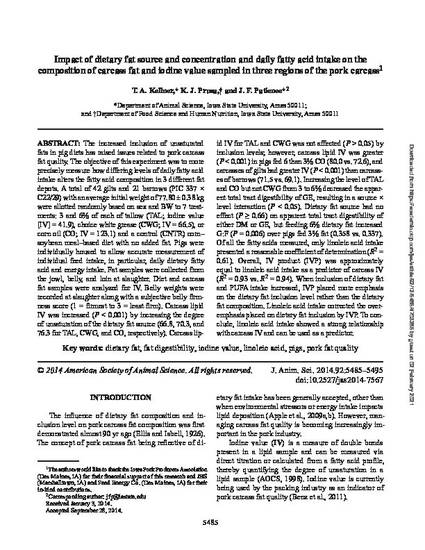
The increased inclusion of unsaturated fats in pig diets has raised issues related to pork carcass fat quality. The objective of this experiment was to more precisely measure how differing levels of daily fatty acid intake alters the fatty acid composition in 3 different fat depots. A total of 42 gilts and 21 barrows (PIC 337 × C22/29) with an average initial weight of 77.80 ± 0.38 kg were allotted randomly based on sex and BW to 7 treatments: 3 and 6% of each of tallow (TAL; iodine value [IV] = 41.9), choice white grease (CWG; IV = 66.5), or corn oil (CO; IV = 123.1) and a control (CNTR) corn–soybean meal–based diet with no added fat. Pigs were individually housed to allow accurate measurement of individual feed intake, in particular, daily dietary fatty acid and energy intake. Fat samples were collected from the jowl, belly, and loin at slaughter. Diet and carcass fat samples were analyzed for IV. Belly weights were recorded at slaughter along with a subjective belly firmness score (1 = firmest to 3 = least firm). Carcass lipid IV was increased (P < 0.001) by increasing the degree of unsaturation of the dietary fat source (66.8, 70.3, and 76.3 for TAL, CWG, and CO, respectively). Carcass lipid IV for TAL and CWG was not affected (P > 0.05) by inclusion levels; however, carcass lipid IV was greater (P < 0.001) in pigs fed 6 than 3% CO (80.0 vs. 72.6), and carcasses of gilts had greater IV (P < 0.001) than carcasses of barrows (71.5 vs. 69.1). Increasing the level of TAL and CO but not CWG from 3 to 6% decreased the apparent total tract digestibility of GE, resulting in a source × level interaction (P < 0.05). Dietary fat source had no effect (P ≥ 0.66) on apparent total tract digestibility of either DM or GE, but feeding 6% dietary fat increased G:F (P = 0.006) over pigs fed 3% fat (0.358 vs. 0.337). Of all the fatty acids measured, only linoleic acid intake presented a reasonable coefficient of determination (R2 = 0.61). Overall, IV product (IVP) was approximately equal to linoleic acid intake as a predictor of carcass IV (R2 = 0.93 vs. R2 = 0.94). When inclusion of dietary fat and PUFA intake increased, IVP placed more emphasis on the dietary fat inclusion level rather than the dietary fat composition. Linoleic acid intake corrected the overemphasis placed on dietary fat inclusion by IVP. To conclude, linoleic acid intake showed a strong relationship with carcass IV and can be used as a predictor.
Available at: http://works.bepress.com/john-patience/107/

This article is published as Kellner, T. A., K. J. Prusa, and J. F. Patience. "Impact of dietary fat source and concentration and daily fatty acid intake on the composition of carcass fat and iodine value sampled in three regions of the pork carcass." Journal of animal science 92, no. 12 (2014): 5485-5495. doi:10.2527/jas.2014-7567.